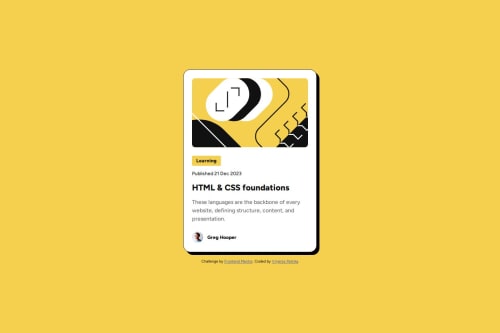Responsive layout using CSS flexbox

Solution retrospective
I am proud that I completed the challenge and now I am getting used to "read" better the figma files. I didn't read all the instructions before starting coding, so I used media queries. Next time I will be more careful.
What specific areas of your project would you like help with?Any feedback is helpful!
Please log in to post a comment
Log in with GitHubCommunity feedback
- P@kaamiik
Some notes which may improve your code:
- Decorative images do not need an alt message. The
altattribute in yourimgtag should be empty, likealt="". It seems that the top image is decorative here. Additionally, note that avatar images do not need alt text either.
- It is recommended to use a proper CSS reset at the start of your CSS file. Both Andy Bell and Josh Comeau offer excellent CSS resets. You can easily find them by searching on the internet.
- Using
font-size: 62.5%;is generally considered a bad practice. It was also mentioned in the last challenge. It is better to adopt the habit of considering1remas equal to16px. This will help maintain consistency and readability.
- It is advisable to use a unitless value for
line-height. This approach ensures better scalability and consistency across different font sizes.
- There is no need to use media queries for the
max-widthof a container in this challenge. You should only have onemax-widthdefined in your CSS.
Marked as helpful - Decorative images do not need an alt message. The
- @TathianiLima
Você foi muito bem, Parabéns!
Minha sugestão é apenas mudar o <html lang="en"> para
<html lang="pt-br">.Marked as helpful
Join our Discord community
Join thousands of Frontend Mentor community members taking the challenges, sharing resources, helping each other, and chatting about all things front-end!
Join our Discord